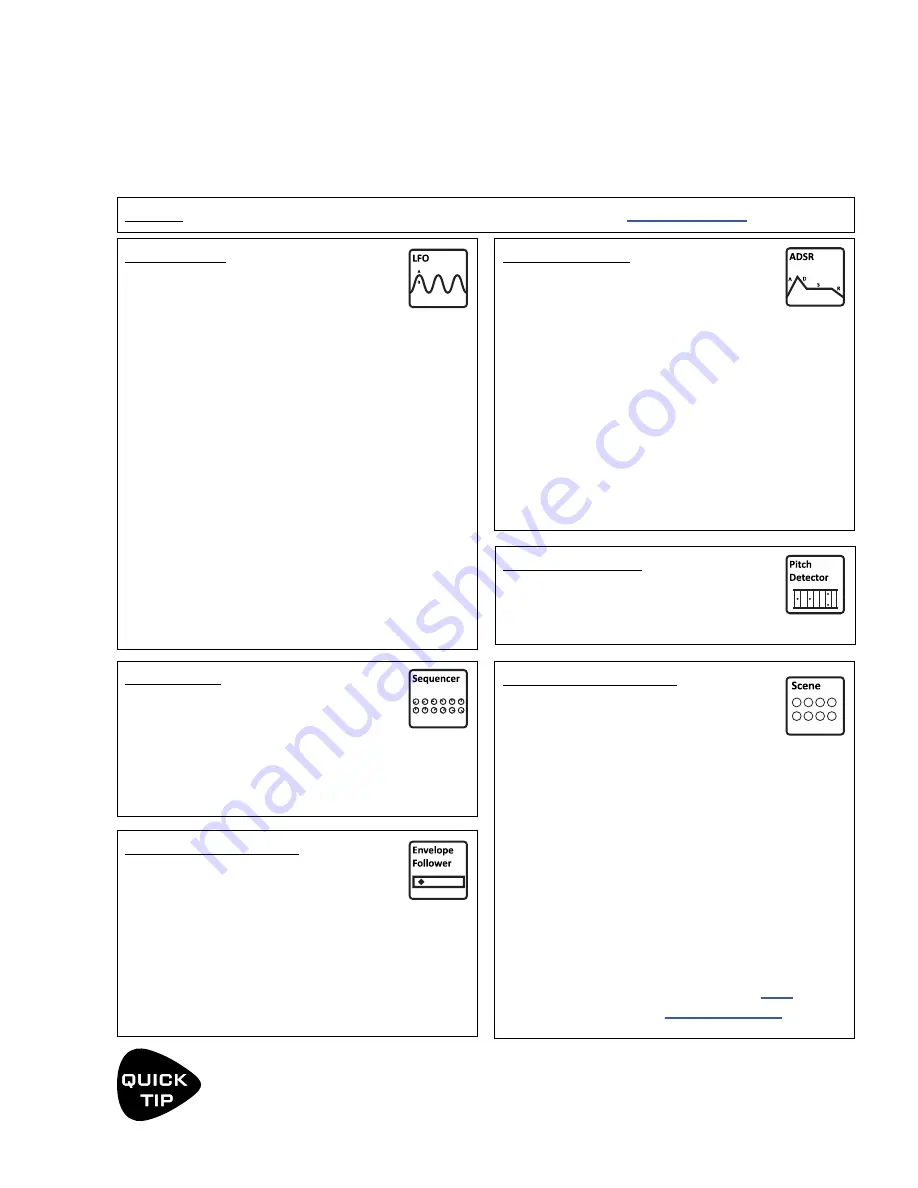
61
9 MODIFIERS
INTERNAL CONTROLLERS
LFO1 & LFO2
A Low Frequency Oscillator (“LFO”)
generates control signals in the form of
a variety of wave shapes. Examples of LFOs in use
include the pulse of a tremolo, the back and forth
sweep of a phaser, or the random filter in Ship Ahoy
by Frank Zappa.
Type sets the shape. You can set the Rate or lock the
LFO to the current Tempo. You can vary the overall
Depth and Duty, or symmetry. The Run parameter
starts and stops the LFO. This can be used to keep it
from drifting out of time.
Each LFO outputs “A” and “B” signals, each of which
is an independent modifier source on the list. You
can change the Phase of output B with respect to A.
Quantize changes smooth waveforms into stepped
ones. Try it on the “TRI” waveform for example.
TEMPO
SEQUENCER
The Step-Sequencer generates control
patterns by looping through 2–32 “stag-
es.” You set the Value for each stage, the
Number of stages, and the Rate or Tempo. The Run
switch allows you to start or stop the sequence.
Damping slurs the change between steps.
SCENE CONTROLLERS
The four Scene Controllers provide a way
to change sound settings from one Scene
to another. Think of each Scene Controller
as a “virtual knob” whose setting can programmed
with a different value in every Scene. By assigning
this knob as a modifier source, you can create “per-
scene” parameters.
For example, you might assign Scene Controller 1 to
Input Drive in the Amp block with a value of 10% in
Scene 1, 50% in Scene 2, 75% in Scene 3, and so on.
As with any source, a scene controller can be
assigned to multiple parameters at the same time,
each with its own modifier settings.
A Scene Controllers tutorial appears on
.
For more on Scenes, see
.
PITCH DETECTOR
The Pitch Detector analyzes the pitch of
your playing and outputs a low value for
low notes and a high value for high notes.
ADSR1 & ADSR2
T
he two ADSR sources are envelope generators
with Attack, Decay, Sustain and Release
parameters (thus “ADSR”). The ADSR is triggered
whenever the signal level exceeds its Threshold measured
at the selected input (1 or 2). The envelope has three self-
explanatory modes (Once, Loop, and Sustain) and can
optionally be set to Retrigger every time the threshold is
exceeded. A Type parameter selects between Linear and
Exponential curves.
In comparison to the Envelope Follower, the ADSR
envelope generator always creates the same control
signal, but only triggers when you play hard enough.
ENVELOPE FOLLOWER
This converts input level to a control signal,
responding variably to your playing dynam-
ics. The classic example is a touch-wah,
where the frequency of the wah varies based on how
hard you play. You can set Attack and Release times
independently, set the trigger Threshold, and adjust
the Gain at the trigger signal input, which can be set
to Input 1 or Input 2.
Internal Controllers can be programmed per-preset for use as modifier sources. To access these parameters,
push the CONTROLLERS button on the Home page (Push-knob
C
) or press TEMPO.
Tempo appears in the Controllers menu. For more information, see
.
The Internal Controllers menu offers four channels for four sets of independent settings for ALL of
the items listed above: four tempos per preset, four sequencer settings, etc. When you change the
channel, ALL of the controllers switch to the new channel and the new settings. Axe-Edit III provides
a way to copy/paste Controller channels.






























